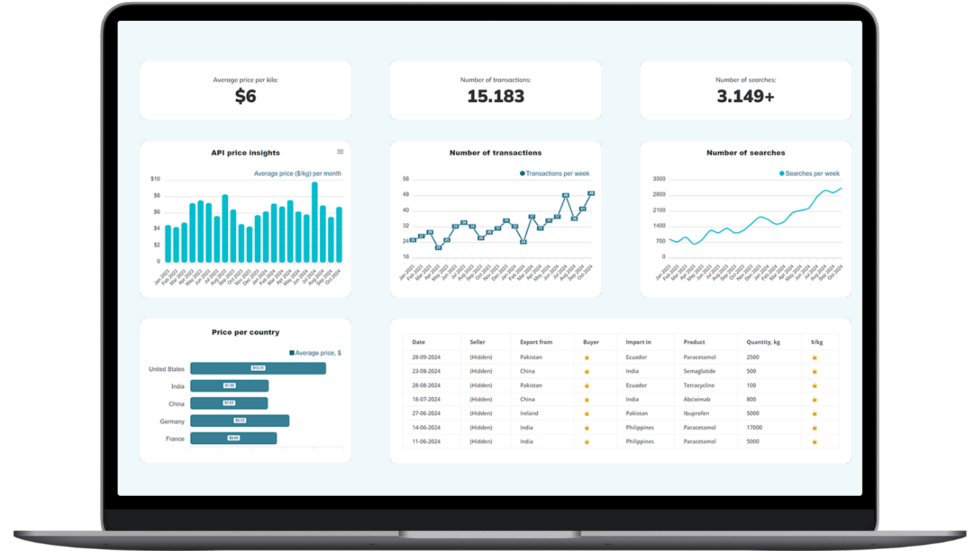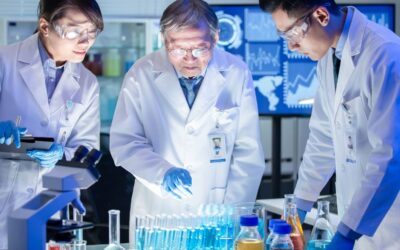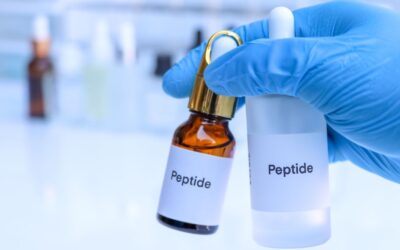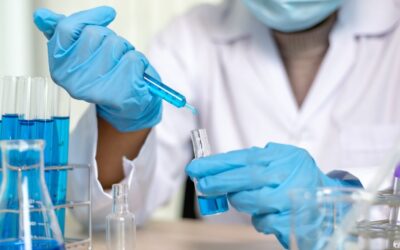Choosing Your Pharma Path:
Production, Analytical Testing, or Formulation

Tânia Marante | Posted on August 01, 2024
Introduction
If you have landed here, it’s safe to say you are interested in the pharmaceutical field. Like any industry, when entering, it’s important to choose the right path for you because different paths will have different outcomes. A question that often reaches us comes from beginners (pharma students and entrepreneurs): Which path should we choose? As pharma experts, we have built this blog to highlight the unique opportunities and challenges of each major field: manufacturing, analytical testing, and formulation to help you opt for a successful and fulfilling career in the pharmaceutical industry. Let’s get into it!
Understanding the areas
What is Pharmaceutical Production?
Pharmaceutical production involves the large-scale manufacturing of drugs and medications. This process transforms raw materials and active pharmaceutical ingredients (APIs) into finished dosage forms, such as tablets, capsules, injectables, and more. The primary goal of pharmaceutical manufacturing is to ensure that the products being made meet stringent quality standards and are safe and effective for patient use.
Key Processes Involved
Let’s understand these key steps and how pharmaceutical manufacturers produce high-quality medications.
- Synthesis is the first step and involves the chemical creation of active pharmaceutical ingredients (APIs) through several reactions and processes to produce the desired compounds. This step is foundational in pharmaceutical production as it generates the core components of medications. By carefully controlling the chemical reactions, manufacturers ensure the consistency and quality of the APIs, for the drug’s effectiveness.
- Fermentation follows as next, a step with particular importance for complex molecules production such as antibiotics. This method uses biological processes, often involving microorganisms like bacteria or yeast, to create these compounds. Fermentation leverages the natural metabolic pathways of these microorganisms to synthesize the desired products. The process is highly controlled to maximize yield and purity, ensuring that the resulting molecules meet stringent quality standards.
- Purification is the process of removing impurities from APIs to ensure the final product’s purity and safety. After synthesis or fermentation, the raw API contains various impurities that must be eliminated. Purification is a sourcing process involving several techniques, such as crystallization, filtration, and chromatography, to isolate the API in its purest form, prevent any adverse effects impurities could cause, and comply with regulatory requirements.
- Formulation refers to the process of combining APIs with excipients, the inactive substances meant to serve as the “vehicle” for the active ingredient to achieve the desired effect for the patient. The formulation ensures the API is stable, effective, and easy to administer. What does this process involve, then? It includes selecting the appropriate dosage form (e.g., tablet, capsule, injectable) and determining the correct proportions of each component to ensure consistent performance.
- Packaging is the final destination and step in pharmaceutical production, where the finished products are safely and securely packed for distribution and use. Proper packaging adds a definite layer of protection to the product from physical damage, contamination, and degradation due to environmental factors like light, moisture, and temperature. Proper labeling, in addition to packaging, is a mandatory regulatory standard for providing essential information to healthcare providers and patients.
Examples of Products Manufactured
- Antibiotics: Medicines used to treat bacterial infections.
- Vaccines: Biological preparations that provide immunity to specific diseases.
- Pain Relievers: Over-the-counter and prescription medications for pain management.
- Hormones: Products like insulin and thyroid hormones used to manage endocrine disorders.
- Cardiovascular Drugs: Medications for managing heart diseases and conditions.
What is Pharmaceutical Analytical Testing?
This branch of the pharmaceutical industry focuses on analyzing and validating drugs and their components. Throughout the drug development process, or manufacturing as we have just seen, to post-market surveillance, testing is yet another way to ensure medications are safe, effective, and of high quality.
Key Techniques and Technologies in Pharmaceutical Analytical Testing
Pharmaceutical analytical testing employs a variety of sophisticated techniques and technologies to ensure the quality, safety, and efficacy of drugs.
Here is an expanded overview of some of the most critical methods used:
High-Performance Liquid Chromatography (HPLC) is a robust analytical technique widely used to separate, identify, and quantify components in a mixture. It operates by passing a liquid sample through a column packed with a solid adsorbent material. Different elements in the sample interact with the adsorbent material to varying degrees, causing them to elute (come out of the column) at different times. This separation allows for the precise identification and quantification of each component.
- Applications: HPLC is commonly used to analyze the purity of APIs, identify impurities, and determine the concentration of drugs in various formulations.
- Advantages: HPLC’s high sensitivity, accuracy, and ability to handle complex mixtures make it indispensable in pharmaceutical testing.
Gas Chromatography (GC) is a technique used to analyze compounds that can be vaporized without decomposition. An inert gas (mobile phase) vaporizes the sample and carries it through a column containing a liquid or solid stationary phase. Different components in the sample interact with the stationary phase to varying extents, causing them to separate as they travel through the column.
- Applications: GC is beneficial for analyzing volatile and semi-volatile organic compounds, including residual solvents, and determining the purity of drugs and intermediates.
- Advantages: GC offers key benefits, including high resolution, rapid analysis, and the ability to handle a wide range of samples.
Spectroscopy encompasses various techniques that measure the interaction of light with matter to determine the molecular composition and structure of substances. Key types include:
- Ultraviolet-visible (UV-Vis) Spectroscopy Measures the absorption of UV and visible light by a sample. It is useful for quantifying the concentration of APIs and detecting impurities.
- Infrared (IR) Spectroscopy analyzes the absorption of infrared light to identify functional groups and molecular structures. It is commonly used for structural elucidation and verifying the identity of compounds.
- Nuclear Magnetic Resonance (NMR) Spectroscopy: Exploits the magnetic properties of specific nuclei to determine the structure, dynamics, and environment of molecules, providing detailed information about molecular structure and purity.
- Advantages: Non-destructive analysis, high specificity, and the ability to provide detailed structural information.
Mass Spectrometry (MS) measures the mass-to-charge ratio of ions to identify and quantify molecules. The sample is ionized, and the resulting ions are separated based on their mass-to-charge ratio using electric and magnetic fields. The detector measures the abundance of each ion, generating a mass spectrum that provides molecular weight and structural information.
- Applications: MS is used for identifying unknown compounds, determining the structure and molecular weight of molecules, and quantifying trace levels of impurities.
- Advantages: MS is a cornerstone of analytical testing because of its high sensitivity, accuracy, and ability to provide detailed molecular information.
Titration is a quantitative analytical method used to determine the concentration of a substance in a solution. It involves gradually adding a titrant (a solution of known concentration) to the analyte (the solution being analyzed) until a reaction endpoint is reached, often indicated by a color change or pH shift.
- Types: Common types include acid-base titration, redox titration, and complexometric titration.
- Applications: Titration is used to assay the concentration of APIs, determine the purity of substances, and quantify components in pharmaceutical formulations.
- Advantages: Simplicity, accuracy, and cost-effectiveness make titration a widely used technique in routine analysis.
What is Pharmaceutical Formulation?
Pharmaceutical formulation is the process of designing and producing the final pharmaceutical product that patients will use. It involves combining APIs with other substances to create a medication that delivers the active ingredient effectively and safely. The formulation must ensure stability, efficacy, and patient acceptability.
Types of Formulations
- Tablets: Solid dosage forms that are easy to administer and provide controlled doses.
- Capsules: Gelatin or vegetarian capsules that contain the active ingredient in a powdered or liquid form.
- Injectables: Sterile solutions or suspensions administered via injection for rapid and targeted delivery.
- Topicals: Creams, ointments, and gels applied to the skin for localized treatment.
- Inhalers: Devices that deliver medication directly to the lungs for respiratory conditions.
Key Steps in the Formulation Process
- Pre-formulation Studies: Investigating the physical and chemical properties of APIs to guide formulation development.
- Selection of Excipients: Choosing inactive ingredients that stabilize and enhance the delivery of the active ingredient.
- Development of Dosage Form: Designing the appropriate form (tablet, capsule, injectable) based on the intended use and patient needs.
- Optimization and Scaling Up: Refining the formulation process for large-scale manufacturing while maintaining quality and consistency.
- Testing and Validation: Conduct extensive testing to ensure the final product meets all safety, efficacy, and quality standards before it is approved for market release.
Comparing the Three Areas: Skill Requirements
If you are considering a career in the pharmaceutical industry, it’s important to not only know the areas but to understand the distinct skill sets required in all three major areas. Although similar, each one demands a unique combination of expertise, knowledge, and personal attributes, making it crucial for beginners to align their skills and interests with the right field.
In this following section we delve in what it takes and the specific requirements for pharmaceutical production, analytical testing, and formulation.
Pharmaceutical Production
Pharmaceutical production professionals need a solid foundation in chemical engineering and manufacturing processes. This expertise includes a deep understanding of chemical reactions, process design, and optimization techniques essential for efficient and scalable manufacturing. Familiarity with various manufacturing processes, such as synthesis, fermentation, and purification, is also necessary to produce high-quality active pharmaceutical ingredients (APIs) and finished drug products.
Good Manufacturing Practices (GMP) play a critical role in pharmaceutical production. GMP ensures that products are consistently produced and controlled according to stringent quality standards. Professionals in this field must have a comprehensive knowledge of GMP guidelines, including documentation practices, quality control measures, and risk management strategies. This understanding is vital to comply with regulatory requirements and ensure the safety and efficacy of pharmaceutical products.
Managing large-scale operations and logistics is another key skill in pharmaceutical production. This field often involves complex, large-scale operations that require practical management skills. Professionals must oversee the entire manufacturing process, coordinate with various departments, manage supply chains, and meet production schedules. Strong organizational and leadership skills are essential to manage these operations efficiently and maintain high productivity levels.
Pharmaceutical Analytical Testing
Analytical testing professionals must thoroughly understand analytical chemistry principles and laboratory techniques. This field relies heavily on various analytical methods, such as chromatography, spectroscopy, and mass spectrometry, to ensure the quality and safety of pharmaceutical products. Expertise in these techniques is necessary to accurately analyze and validate the components of drugs, detect impurities, and ensure compliance with quality standards.
Regulatory requirements are a significant aspect of analytical testing. Professionals must be familiar with the guidelines set by regulatory agencies such as the FDA and EMA. This includes understanding the requirements for method validation, documentation, and reporting. Compliance with these regulations is crucial to ensure the reliability and accuracy of test results, which directly impact the approval and market release of pharmaceutical products.
Precision and attention to detail are paramount in analytical testing. The nature of this work demands meticulousness, as accurate results are essential for determining the quality and safety of pharmaceutical products. Professionals must ensure that all tests are performed correctly, data is accurately recorded, and results are precisely interpreted. This high level of precision is critical to maintaining the integrity of the testing process and the overall quality of the pharmaceutical products.
Pharmaceutical Formulation
Formulation scientists need a deep understanding of pharmaceutical sciences, including pharmacology, pharmaceutics, and biopharmaceutics. Proficiency in formulation technologies and techniques, such as granulation, encapsulation, and spray drying, is also essential. This knowledge allows professionals to develop stable, effective, and patient-friendly drug products that meet therapeutic needs.
Creativity and problem-solving skills are vital in pharmaceutical formulation. Developing new drug products often involves overcoming various challenges related to drug stability, bioavailability, and patient acceptability. Formulation scientists must be able to think creatively and develop innovative solutions to these challenges. Problem-solving solid skills enable them to address issues effectively and create formulations that optimize the therapeutic effects of drugs while minimizing side effects.
Formulation scientists also need an in-depth understanding of pharmacokinetics and drug delivery systems. Pharmacokinetics involves understanding how drugs are absorbed, distributed, metabolized, and excreted in the body. This knowledge helps design drug delivery systems that maximize the drug’s therapeutic effects. Familiarity with various drug delivery technologies, such as controlled-release systems and targeted delivery, is important to ensure that the drug reaches the desired site of action in the body effectively.
What Area Has the Highest Demand?
While all three areas—production, analytical testing, and formulation—are experiencing significant demand, the highest demand currently appears to be in pharmaceutical production. This is due to the continuous and large-scale need for medication manufacturing driven by chronic diseases, aging populations, and global health emergencies. However, analytical testing and formulation are rapidly growing sectors with increasing importance due to regulatory requirements, quality assurance needs, and innovations in drug development, particularly in high-demand therapeutic areas like oncology and biologics.

Make Smarter API Decisions with Data
Access exclusive insights on global API pricing, export/import transactions, competitor activities and market intelligence.
Conclusion
Choosing the right area to focus on in the pharmaceutical industry can be a challenging decision for beginners. Each area—production, analytical testing, and formulation—offers unique opportunities and requires different skills, investments, and regulatory considerations. We hope that by understanding the basics, comparing the demands, and exploring real-world case studies, aspiring professionals can make informed decisions about where to start their pharmaceutical journey. Whether you choose to compete in the production, analytical testing, or formulation event of the Pharmaceutical Startup Olympics, success will depend on careful planning, dedication, and a commitment to excellence.






Check out all other blogs here!